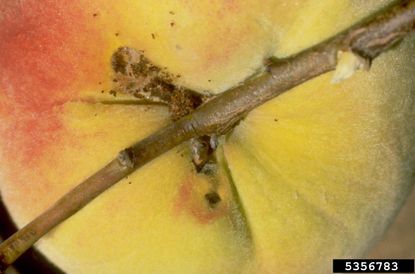What Are Peach Twig Borers: Learn About The Peach Twig Borer Life Cycle


Peach twig borers are the larvae of plain-looking gray moths. They damage new growth by boring into the twigs, and, later in the season, they bore into the fruit. Find out how to manage these destructive pests in this article.
What are Peach Twig Borers?
Don’t confuse the peach twig borer with the peach tree borer. The twig borer bores into tender new growth tips, causing them to wilt and die back. The tree borer bores into the trunk of the tree. Both the peach twig and peach tree borer attack stone fruit such as peaches, nectarines, and plums, and can ruin a crop.
Peach Twig Borer Life Cycle
Peach twig borers have two to five generations every year, depending on the climate where you live. The larvae overwinter under the tree bark, and then make their way to emerging shoots in late winter. They tunnel in and feed until they are mature enough to pupate. Later generations tunnel into the stem end of the fruit. Crevices in the bark provide hiding places for the larvae to pupate. The adults are plain gray moths that begin laying eggs on the undersides of leaves right away. The generations often overlap so that you can find several life stages in the tree at the same time.
Methods of Peach Twig Borer Control
Peach twig borer control requires careful timing. Here is a list of sprays along with general timing guidelines.
- Spray horticultural oils before the buds begin to swell.
- Around bloom time you can spray Bacillus thuringiensis. You’ll need to spray two to three times per generation when you expect a few days of warm weather.
- Spray with spinosad when the petals fall from the flowers.
Damage from peach twig borers is quite serious on young trees. The insects can kill an entire season of new growth by feeding on the twig tips. Later generations disfigure the fruit and render it inedible. The good news is that trees generally recover once the insect is gone. Young trees may experience a setback, but there is no reason they can’t produce a crop in future seasons.
Gardening tips, videos, info and more delivered right to your inbox!
Sign up for the Gardening Know How newsletter today and receive a free download of our most popular eBook "How to Grow Delicious Tomatoes."

Jackie Carroll has written over 500 articles for Gardening Know How on a wide range of topics.
-
 Clever Vertical Vegetable Garden Ideas For Small Spaces – 7 Ways To Save Space
Clever Vertical Vegetable Garden Ideas For Small Spaces – 7 Ways To Save SpaceShort on garden space? Learn some vegetable garden ideas for small spaces that are fun and easy.
By Mary Ellen Ellis
-
 26 Different Types Of Orchids – With Pictures & Information
26 Different Types Of Orchids – With Pictures & InformationDiscover stunning orchid types to grow in your home and garden – from easy beginner varieties to rare and exotic species that are the preserve of experts.
By Melanie Griffiths